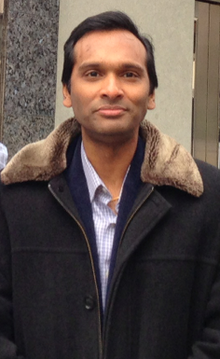Arul Chinnaiyan
Arul Chinnaiyan | |
|---|---|
 | |
| Alma mater | University of Michigan Medical School |
| Known for | Cancer Research |
| Scientific career | |
| Institutions | University of Michigan Medical School, Howard Hughes Medical Institute |
Arul M. Chinnaiyan is a Hicks Endowed Professor of Pathology and professor of pathology and urology at the University of Michigan Medical School.[1] He is also a Howard Hughes medical Investigator (HHMI) at the Howard Hughes Medical Institute.[2]
Arul Chinnaiyan received both PhD and MD degrees at the University of Michigan Medical School in 1999. He is a cancer researcher and the recipient of the 28th annual American Association for Cancer Research Award for Outstanding Achievement in Cancer Research at the annual meeting of the AACR in April 2008 in San Diego.[3] He was also the leader of a group of scientists who received the inaugural 2007 American Association for Cancer Research "Team Science" Award for their discovery of gene fusions in prostate cancer.[4]
Arul Chinnaiyan received a number of other awards and prizes, including the Burroughs Wellcome Fund Clinical Scientist Award in Translational Research and of the Ramzi Cotran Young Investigator Award from the United States and Canadian Academy of Pathology. He is an elected member of the American Society for Clinical Investigation.[5]
He is a member of the editorial board for Oncogene.[6]
Research and discovery
[edit]The focus of his research is molecular profiling of cancer to discover novel diagnostic markers and therapeutic targets. It is generally believed that blood cancers are caused by chromosome translocation such as Bcr-Abl in chronic myelogenous leukaemia (CML), whereas solid tumors are caused by mutations in growth or tumour suppressor genes. In research which challenges the current dogma, Arul has discovered chromosome translocation in solid prostate tumours. Arul has discovered that this translocation occurs between a male hormone related gene TMPRSS2 and transcription factors of the Erythroblast transformation specific (ETS) family.[7]
Publications
[edit]Partial list:
- Hu, M; Yu, J; Taylor, JM; Chinnaiyan, AM; Qin, ZS (April 2010). "On the detection and refinement of transcription factor binding sites using ChIP-Seq data". Nucleic Acids Res. 38 (7): 2154–67. doi:10.1093/nar/gkp1180. PMC 2853110. PMID 20056654.
- Narla, G; DiFeo, A; Fernandez, Y; et al. (August 2008). "KLF6-SV1 overexpression accelerates human and mouse prostate cancer progression and metastasis". J. Clin. Invest. 118 (8): 2711–21. doi:10.1172/JCI34780. PMC 2441856. PMID 18596922.
- Prensner, JR; Chinnaiyan, AM (December 2009). "A FIRE-y PAGE in the computational analysis of cancer profiles". Mol. Cell. 36 (5): 732–3. doi:10.1016/j.molcel.2009.11.019. PMID 20005836.
- Khan, AP; Poisson, LM; Bhat, VB; et al. (February 2010). "Quantitative proteomic profiling of prostate cancer reveals a role for miR-128 in prostate cancer". Mol. Cell. Proteomics. 9 (2): 298–312. doi:10.1074/mcp.M900159-MCP200. PMC 2830841. PMID 19955085.
- Mathew, JP; Taylor, BS; Bader, GD; et al. (February 2007). "From bytes to bedside: data integration and computational biology for translational cancer research". PLOS Comput. Biol. 3 (2): e12. Bibcode:2007PLSCB...3...12M. doi:10.1371/journal.pcbi.0030012. PMC 1808026. PMID 17319736.
- Ateeq, B; Tomlins, SA; Chinnaiyan, AM (December 2009). "AGTR1 as a therapeutic target in ER-positive and ERBB2-negative breast cancer cases". Cell Cycle. 8 (23): 3794–5. doi:10.4161/cc.8.23.9976. PMC 2940713. PMID 19934656.
- Mani, RS; Tomlins, SA; Callahan, K; et al. (November 2009). "Induced chromosomal proximity and gene fusions in prostate cancer". Science. 326 (5957): 1230. Bibcode:2009Sci...326.1230M. doi:10.1126/science.1178124. PMC 2935583. PMID 19933109.
- Wang, XS; Prensner, JR; Chen, G; et al. (November 2009). "An integrative approach to reveal driver gene fusions from paired-end sequencing data in cancer". Nat. Biotechnol. 27 (11): 1005–11. doi:10.1038/nbt.1584. PMC 3086882. PMID 19881495.
- Vellaichamy, A; Sreekumar, A; Strahler, JR; et al. (2009). "Proteomic interrogation of androgen action in prostate cancer cells reveals roles of aminoacyl tRNA synthetases". PLOS ONE. 4 (9): e7075. Bibcode:2009PLoSO...4.7075V. doi:10.1371/journal.pone.0007075. PMC 2740864. PMID 19763266.
- Gust, KM; Hofer, MD; Perner, SR; Kim, R; Chinnaiyan, AM; Varambally, S; Moller, P; Rinnab, L; Rubin, MA; Greiner, J; Schmitt, M; Kuefer, R; Ringhoffer, M (September 2009). "RHAMM (CD168) is overexpressed at the protein level and may constitute an immunogenic antigen in advanced prostate cancer disease". Neoplasia. 11 (9): 956–63. doi:10.1593/neo.09694. PMC 2735808. PMID 19724689.
- Khodadoust, MS; Verhaegen, M; Kappes, F; et al. (August 2009). "Melanoma proliferation and chemoresistance controlled by the DEK oncogene". Cancer Res. 69 (16): 6405–13. doi:10.1158/0008-5472.CAN-09-1063. PMC 2727675. PMID 19679545.
References
[edit]- ^ "University of Michigan Medical School Department of Pathology website". Archived from the original on 4 May 2007. Retrieved 21 April 2008.
- ^ HHMI: Arul M. Chinnaiyan, M.D., Ph.D
- ^ List of AACR Award for Outstanding Achievement in Cancer Research Winners Archived 5 May 2008 at the Wayback Machine
- ^ AACR Team Science Award Recipients Archived 10 March 2014 at the Wayback Machine, American Association for Cancer Research Award citation:"In recognition of their landmark discovery of recurrent gene fusions in a majority of prostate cancers, which has profound clinical and biological implications for understanding prostate cancers, and their embodiment of team science through interdisciplinary and inter-institutional collaboration."
- ^ 2 UMHS researchers selected as Howard Hughes Medical Institute investigators. Archived 21 April 2008 at the Wayback Machine University of Michigan Health System Press Release. 12 October 2007
- ^ "Editorial Board | Oncogene".
- ^ Tomlins, SA; Laxman, B; Dhanasekaran, SM; Helgeson, BE; Cao, X; Morris, DS; Menon, A; Jing, X; Cao, Q; Han, B; Yu, J; Wang, L; Montie, JE; Rubin, MA; Pienta, KJ; Roulston, D; Shah, RB; Varambally, S; Mehra, R; Chinnaiyan, AM (2007). "Distinct classes of chromosomal rearrangements create oncogenic ETS gene fusions in prostate cancer". Nature. 448 (7153): 595–9. Bibcode:2007Natur.448..595T. doi:10.1038/nature06024. hdl:2027.42/62659. PMID 17671502. S2CID 4361134.
